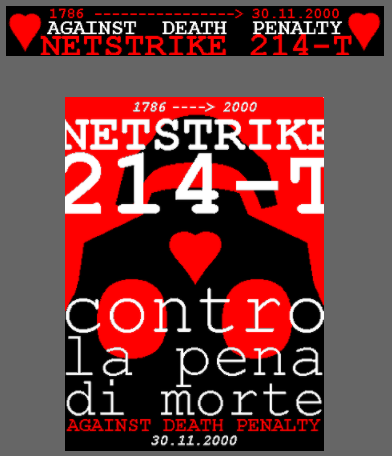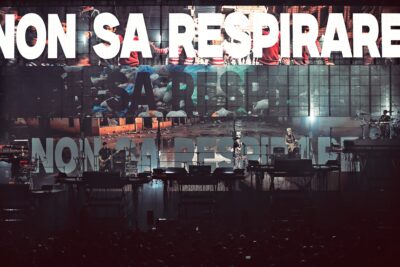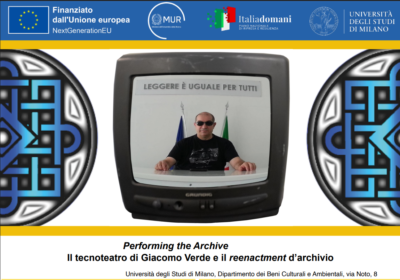Connessioni Remote (CR_ARTT) is a peer-reviewed Journal of Arts, Theatre and Technologies directed by Anna Maria Monteverdi and published by the University of Milan, Italy Department of Cultural Heritage and Environment
We invite you to submit an abstract of your research for possible publication in the Journal.
Last date of submission is: 15th November 2020.
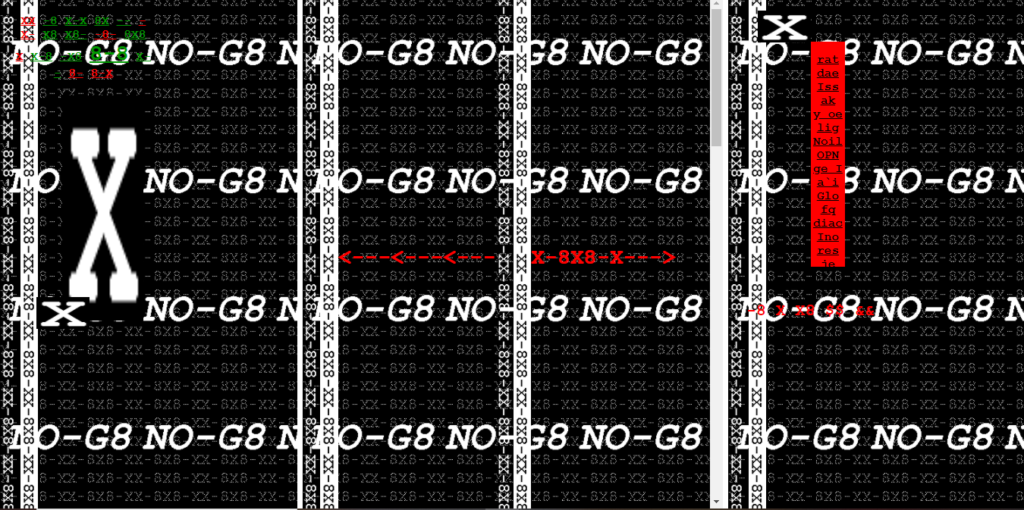
Artivism: Forms, Experiences, Practices and Theories
Anna Maria Monteverdi Dalila D’Amico Laura Gemini Vincenzo Sansone
For me, Artivism is definable as when artistic action consciously goes hand in hand with political action, or when it is aware of the political value it puts in place. And incidentally, art, as a public action, is always political even if it would rather not be so. It’s about deciding which side to stand on.Artivism was born in a context that is recognizable in the collective author, in the art-life combination and in overcoming the object of art. And this is a precise choice of field. The hybridisation between art and activism should produce a double action: in the activist field give more space to creative communication, and in the artistic field, increase the sense of political responsibility in one’s choices. Giacomo Verde
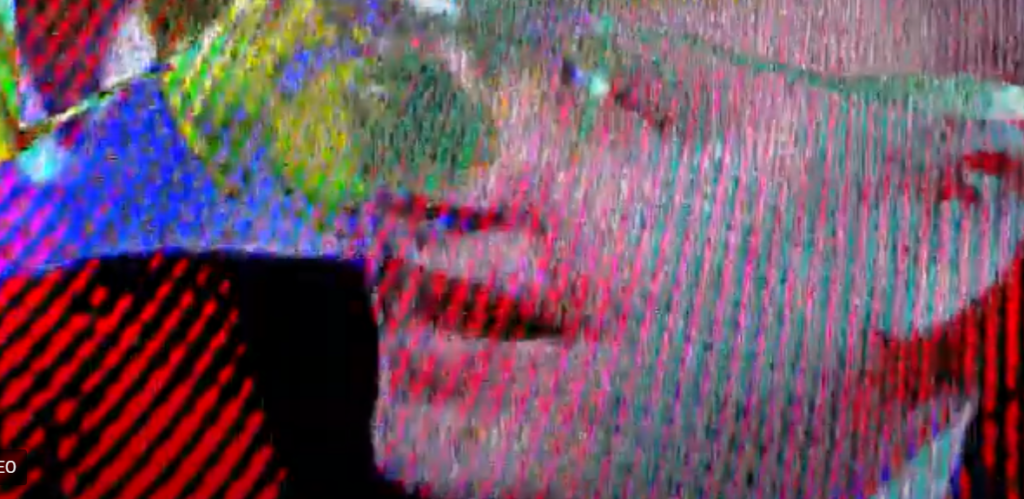
Artivism is a term that indicates the union between art and political activism, a combination that has a long histoy but which has only been defined more recently, in relation to the appearance of the first telematic networks in the 1980s, and then spread with the development of internet and digital culture. As a practice that is configured through the actions of artists and collectives, characterised by a strong vocation for social and political commitment (Bazzichelli 2006; 2013), artivism crosses different fields of expression – performance, street art, video art, net art, subvertising, guerrilla marketing – and uses media languages and formats from an antagonistic, critical and counter-information perspective.
In his seminal essay Aldo Milohnić explains that artivism is a kind of “interventionism” which uses “cultural-manifestation techniques in order to become constituted in the field of the political” (p. 18). Furthermore, “the transversality of these practices and their hybrid nature enable quick passages from the predominantly artistic into the predominantly political sphere and back” (Milohnić 2005, p. 24).
The author and the date of birth of the term “artivism” is disputed but it become synonymous with the political commitment of artists on a global scale.
The 1999 Seattle protests and the contemporary and remarkable artistic intervention by the Electronic Disturbance Theater (founded by Ricardo Dominguez) in relation to the Virtual Sit-in in solidarity with the Zapatista Communities in Chiapas (Drew 2005; Wray 1998), showed that digital technologies and networks had become the core of a social, political and artistic mobilisation.
According to Bazzichelli we also need to go as far back as the mid-1990s and remember the contribution to the artivism made by cyberpunk network, hackmeetings and self-managed social centres, especially in Italy (Bazzichelli, 2001).
Accompanying this evolution is the mediatisation process which, in general terms, is characterised as a dynamic of cultural and social transformation influenced by the media; in the case of art it becomes evident in the forms of “media activism”. The movement analysed by Matteo Pasquinelli in Mediactivismo (2002), refers to practices emergent as early as the Sixties and Seventies, developed in the Eighties and overturned in 1999 with the Seattle protests, using platforms such as Indymedia, and through the creation of Independent Media Centers (IMC) for the discussion and sharing, through mailing lists, of the guidelines on the alternative use of the media, making sure to guarantee broad representativeness to all areas of activism: sexual, racial, etc.
Around the 2000s and following the spread of social media, online platforms have become a particularly interesting field for experimenting with the experiences of art and for the dissemination of ideas from a participatory perspective.
Artivism has certainly had maximum diffusion thanks to some milestone such as: AHA: Activism-Hacking-Artivism project (mailing list and exhibition event on media activism) by Tatiana Bazzichelli, 2002 and her book Networking: la rete come arte, 2006); the first monographic essay on the Artivism in the Performing Arts by the Slovenian scholar Aldo Milohnić in the Academic Journal Maska (2005) and the autobiographical monograph by Giacomo Verde Artivismo tecnologico (2007).
This second issue of “Connessioni Remote” intends to provide a mapping of the different practices that, from the late 1990s to today, nourish the paths of Artivism in order to reconstruct their stories and probe their forms, so as to investigate the most recent experiences with particular attention to digital and web based practices, intended as privileged observation places, not only of contemporary aesthetics, but of the processes of connection and sharing between artists and audiences, which then allow us to grasp and analyse the political impact of today’s forms of digital Artivism.
Contributions can address the following issues, but not exclusively:
– recognition of studies and research on Artivism
– recognition and analysis of online Artivism practices
– the creativity and sharing of actions on social media platforms
-artivism in new digital art formats (digital cultural jamming; light painting; video projection mapping)
-artivism and public art
– methods of analysis of artistic practices: critical thinking
– recognition and analysis of the problems concerning the link between art and Artivism (privacy, authorship, copyright, cultural appropriation)
– objectives and areas of political orientation of contemporary artistic practices: feminism and queer cultures; Artivism and corporeality; post-colonial contexts; racial justice;
-artivism and environmentalism,
-artivism and the geographies of migration
-strike art and guerrilla performance
– artivistic performative actions (individual and group artivistic practices, artivistic actions as part of protest manifestations, etc.)
– case studies and monographic contributions
Deadline for abstracts submission: 15th November 2020
Send your abstract at mailto:rivistaconnessioni.remote@gmail.com
For more information, visit the official website of the journal:
https://riviste.unimi.it/index.php/connessioniremote/index
Authors are invited to submit abstracts on any of the given topics in Italian and English of 1,000 characters max (including spaces) with the addition of 4-5 keywords.
The Editorial Committee will privilege the abstracts which propose an advancement of knowledge and elements of innovation in the current critical debate, in terms of artistic and/or performative practices, and in theoretical and methodological fields.
After the reviewing process of the abstract, the Journal will contact you by email to communicate the modalities to submit the final text electronically using the OJS platform by registering online. Only manuscripts of sufficient quality that meet the aims and scope of CR_ARTT Journal will be reviewed.
Full papers should be between 30.000-40.000 characters, including notes and references; they should not have been previously published and they may be presented in English or in Italian. Authors are kindly requested to refer to the manuscript-type-specific guidelines.
The articles selected will be subject to double blind refereeing
Documentations of performances and web based works are welcome.
Info: mailto:rivistaconnessioni.remote@gmail.com
References
Special Issue on Artivism in “Maska”, edit by Aldo Milohnić, vol. XX, no 1-2 (90-91), 2005
L. Baigorri, Recapitulant: models d’Artivisme (1994-2003), “Artnodes”, n. 3, 2004, https://www.raco.cat/index.php/Artnodes/article/view/53056
T. Bazzichelli, L’arte come pratica reale dalle avanguardie agli hackmeeting, La critica.net, web, 7 luglio 2001 http://www.lacritica.net/bazzichelli2.htm
T. Bazzichelli,Dell’arte, del cyberpunk, dell’hacking, Punto informatico.it, web, 27 luglio 2001 puntoinformatico.it).
T. Bazzichelli, Networking. La Rete come arte, Costa&Nolan, Milano 2006; English Edition: Networking. The Net as Artwork, Digital Aesthetic Research Center of the Aarhus University , Aarhus 2008
T. Bazzichelli, Networked Disruption: Rethinking Oppositions in Art, Hacktivism and the Business of Social Networking, Digital Aesthetics Research Center of the Aarhus University, Aarhus 2013
F. Berardi “Bifo”, Skizomedia, 30 anni di mediattivismo, Derive e Approdi, Roma 2006
Autistici/Inventati, L. Beritelli, +Kaos. 10 anni di Hacking e mediattivismo, Agenzia X, Milano, 2012; first edition in English: Institute of Network Cultures, Amsterdam 2017.
A. Di Corinto, T. Tozzi, Hacktivism. La libertà nelle maglie della rete, Manifestolibri, Roma 2002
D. Danko Artivism and the Spirit of Avant-Garde Art in: Alexander V., Hägg S., Häyrynen S., Sevänen E. (eds), Art and the Challenge of Markets Volume 2. Sociology of the Arts, Palgrave Macmillan, London 2018.
M. Dragicevic Sesic, A. Brkic, J.Matejic, Mobilizing urban neighbourhoods: Artivism, identity, and cultural sustainability, in: S. Hristova, M. Dragicevic Sesic, N. Duxbury, (eds), Cultural Sustainability in European Cities: Imagining Europolis, Routledge, London 2015
J. Drew, From the Gulf War to the Battle of Seattle: Building an International Alternative Media Network, in A. Chandler, N. Neumark, At a Distance. Precursor to Art and Activism on the Internet, Mit Press, Boston 2005
B. Groys. On Art Activism. e-flux Journal n.56, 2014 http://www.e-flux.com/journal/on-art-activism.
S. Lemoine, S. Ouardi, Artivisme. Art, Action Politique et Résistance Culturelle, Éditions Alternatives, Paris 2010
S. Loewe, When Protest Becomes Art: The Contradictory Transformations of the Occupy Movement at Documenta 13 and Berlin Biennale 7, “Field Journal” Web, Spring 2015
A. Milohnić, Artivism, “Maska” (Ljubljana), vol. 20, no. 1-2 (90-91), 2005, pp.15-25; reprinted/translated in: “Transversal”, no. 2, 2005; “Performance Research” (title: Direct Action and Radical Performance), vol. 10, no. 2, 2005, pp. 47-58; Sodobne scenske umetnosti [Contemporary Performing Arts], ed. by B. Kunst and P. Pogorevc, Maska, Ljubljana, 2006, pp. 184-207; “Kazaliste”, vol. 14, no. 47-48, pp. 24-37; Parallel Slalom, ed. by B. Cvejic and G. S. Pristas, TkH and Academy of Dramatic Art, Belgrade/Zagreb, 2013, pp. 215-235; Teorije savremenog teatra i performansa. [Theories of Contemporary Theatre and Performance], Orion art, Belgrade, 2013, pp. 131-148; Art and Theory of Post-1989 Central and Eastern Europe: A Critical Anthology, ed. by A. Janevski, R. Marcoci and K. Nouril, The Museum of Modern Art, New York, 2018, pp. 252-257
A. Milohnić, Artivistic Interventions as humorous Re-appropriations, “European Journal of Humour Research”, vol. 3, no. 2-3, 2015, pp. 35-49; French translation in: “Théâtre Public”, n. 222, 2016.
S. Niehoff, Unmasking the Fake. Theatrical Hoaxes from the Dreadnought Hoax to Contemporary Artivist Practice, in: D. Becker, A. Fischer, Y. Schmitz, (eds.), Faking, Forging, Counterfeiting. Discredited Practices at the Margins of Mimesis, transcript Verlag, Bielefeld 2018.
M. Park, V.Jeremic, R. Raedle, (eds), Reality Check – Art & Activism Reader. Trondelag enter for Samtidskunst, Trondheim 2010
M. Pasquinelli, (ed.), Media activism: strategie e pratiche della comunicazione indipendente, Derive e Approdi, Roma 2002.
S. Pisano, Hacktivism, Hacker art disobbedienza civile elettronica, LuxFlux.net web, n. 37, 2009
D. Rodney, Re/imagining Artivism, in D.J. Elliott, M. Silverman, W. Bownman (ed.), Artistic Citizenship: Artistry, Social Responsibility, and Ethical Praxis, Oxford University Press 2016
A. E. Smith, Zapatismo in cyberspace: Interview with Ricardo Dominguez, Rhizome.org, Jan 26, 2016 https://rhizome.org/editorial/2016/jan/26/interview-with-ricardo-dominguez/
F. Vlavo, Performing Digital Activism. New Aesthetics and Discourses of Resistance, Routledge, London 2017
G. Verde, Artivismo tecnologico, Edizioni BFS, Biblioteca Franco Serantini, Pisa 2007
P. Weibel. Global Activism: Art and Conflict in the 21st Century, Mit Press, Boston 2015
S. Wray, The Electronic Disturbance Theater and Electronic Civil Disobedience, The thing.net, web, 17 giugno 1998.


